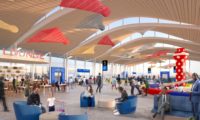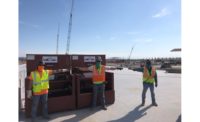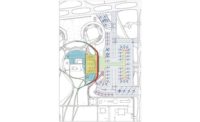Long a relic of an aviation vision that never came to fruition, Kansas City International Airport is joining the single-terminal world in a big way.
Twenty-five 135-ft-long, 80,000-lb steel box beams extend from the back wall of the new KCI head house to the departures area. Those giant beams form part of the roof for the drop-off area of the largest and most expensive single infrastructure project in Kansas City history.
Below the 800-ft-long head house, an elevated roadway that needed its own concrete reinforcement columns complicated installation of the box beams and the steel Y-columns that hold them up.
“You’ve got three points of contact, one in the back of the head house and the two points of a Y-column with a significant cantilever to cover the curbside drop-off,” says Mark Goodwin, vice president with Clark Construction Group and operations leader for the KCI Airport single terminal project. “It’s a significant architectural element and a lot of time was spent studying the structure and how to design it, but then [also] how to build it. This is the only area where we had to leave out slab-on-grade work until after we erected the steel.”
Before the box beams could be installed, the Clark/Weitz/Clarkson design-build joint venture contractor delivering the project had to erect one precast concrete wall of the head house, much like first building a load-bearing interior wall before what goes around it in a Lego house.
“The front door of the head house is precast—the whole length of it,” says Chris Smith, a construction executive at Clark Construction and the leader of field operations for the KCI project. “We actually came in and set all the precast panels for it out in the middle of nowhere, temporarily supported them and then erected all this over top of it. If we built the roadway first and erected the Y columns, there’s no way that we would have been able to get in there for that wall.”
Smith says Clark/Weitz/Clarkson placed its grade beam and anchored and braced the panels so they could stand by themselves until the rest of the head house, the steel Y-columns and the box beams from fabricator ADF International could be delivered.
The Y-columns were shipped from Montreal in two separate pieces, put together on site and lifted as one piece. Once the head house wall and all of the Y-columns were in place, the box beams could be lifted into their three points of contact and welded into place by steel erector National Steel City. The process had to be repeated for 25 columns and beams down the length of the head house and the cantilevered roof. This complicated steel erection was just one of the challenges faced by the design-build contractor.
Terminating the Triad
In 2017, the voters of Kansas City, Mo., overwhelmingly decided to end the three-terminal experiment that had been Kansas City International Airport since it opened in 1972.
Seventy-five percent of voters chose what would become a $1.5-billion-guaranteed-maximum-price, single-terminal design by SOM to replace the three drive-up terminals at KCI that were designed for a potential future filled with supersonic jets. That vision evaporated in the 1980s with former anchor airlines TWA and Braniff. In 2014, the existing KCI terminal A was shut down and the Dept. of Aviation began seriously looking at becoming a single-terminal airport.
“Security was really a challenge, and it remains so with different gates with different security checkpoints,” says Daniel Moylan, who is managing the developer- led single-terminal KCI for Edgemoor Infrastructure and Real Estate. “It requires a lot more TSA employees and just a lot more effort to operate than you would with a single check-in terminal.”
After a contentious city council selection process and a November 2017 referendum approving their proposal, Edgemoor, the Kansas City Dept. of Aviation, SOM and Clark/Weitz/Clarkson got to work discussing what the residents of Kansas City wanted in both an airport and the workforce that delivered it.
“We recognized early on that it was going to be a legacy project for the city,” Moylan says. “It was not just going to be the single largest public infrastructure project they’ve ever done, but it was also a very high profile because of the nature of the voting.”
The end product of meetings with all six city council voting districts in Kansas City resulted in a plan for 1.1 million sq ft of an H-shaped single terminal with 39 gates and 21 overnight plane parking spaces, a 6,300-space parking garage and airside and landside civil improvements for everything from electri- cal and water service for the new terminal to jet fuel lines. KCI’s airlines—including the biggest gate-holder, Southwest Airlines—agreed to entirely pay back the aviation department’s construction bonds for the project from gate fees and other airport revenue. AVAir- Pros represented Southwest, Delta, United, American and other airlines in negotiations with the Aviation Dept. for the use of lease agreement.
Completion of the new single terminal is expected by 2023. JE Dunn is the subcontractor responsible for the parking garage, and Capital Electric and US Engineering are the major design-build subcontractors.
“[A single terminal design] provides the best platform for expanded service,” says Derek Moore, the SOM director who led the design team. “They were hamstrung from growing due to the existing terminals. A single terminal will be way more efficient to operate for maintenance.”
SOM delivered an airy steel and glass design that would have made famed Bauhaus-style designer Ludwig Mies van der Rohe proud that a commitment to the international style still exists between Mexico City and Brasilia avenues in Kansas City. Moore says the design team wanted to still allow residents to wave at each other through glass walls, as is possible from the three smaller terminals, while creating more space for modern entertainment and security areas inside the airport. Another architecturally desirable aspect of the cantilevered box beam and Y support design is that it allows an 800-ft-long by 90-ft-wide clear base. There are no columns in the head house.
Because the single terminal is being built almost entirely on the existing terminal A site, it hasn’t affected ongoing operations of terminals B and C since construction began in 2019. The airport will still have land available for future expansion, including new runway capacity, once those older terminals are demolished. However, supporting a 1.1-million-sq-ft single terminal on land originally designed for Jetsons-style miniterminals created more challenges.
Adding additional paving required a deep box culvert with 7-ft by 7-ft sections that could be tied into the existing stormwater system for the length of the new terminal.
“The volume of water was a challenge that we had to focus on from the beginning of the design phase,” Goodwin says. “That was a utility that certainly had to go in early based upon its depth.”
In many ways, delivering the project via progressive design-build helped keep the many civil, steel, electrical and other tasks going early on while design for the building continued. It also helped when the pandemic hit in March 2020 and trade contractors had to maintain social distancing of workers.
“We were erecting steel that was going to be the steel that supported the curtain wall before we were at IFC [issued for construction] level for the rest of the building,” Goodwin says. “We were issuing foundation packages, followed by steel packages, followed by curtain wall packages in a progressive nature that really required an extraordinary or extreme amount of coordination between the design assist subcontractors and our design team.”
To handle the transfer of so much information, Clark/Weitz/Clarkson is using the level of development specification, a voluntary BIM methodology from the BIM Forum that puts a “level,” from conceptual to shop-drawing level of detail, on what’s contained in a model.
“We’ve got hand-offs with the architect of the architectural model to the subcontractor,” says Weitz Co. senior project manager Ben Bunge, who is in charge of coordination on the KCI project. “In some cases, our design-build subcontractor takes that information at anywhere from a Level 200 or up to Level 400.”
Bunge says Clark/Weitz/Clarkson is also working with Arora Engineers as an integrator to turn the design and construction team’s Revit models into operations and facilities maintenance models for the Kansas City Dept. of Aviation.
The project is on schedule to open in March 2023.
Building an MWBE Program That Builds
Various workforce enhancement programs at the Kansas City International Airport terminal project aim to deliver the project commitment of reinvesting up to about $23 million of its earnings into the local community to support diversity in the workforce and build the capacity of local small businesses owned by minorities and women. The programs at KCI include workforce training, a general contractor training program, a project internship program, transportation, extended-hours child care, onsite health care and four MWBE-specific support programs, and an MWBE-specific supplier support program.
“We have programs related to and that help to build the capacity of [MWBEs by means of] a strategic partnership program, a pay without delay program,” says Latoya Goree, executive director and onsite ombudsman for terminal workforce enhancement programs for Edgemoor and Clark/Weitz/Clarkson.
“We have loan programs, self-bonding,” Goree says. As far as support and an incubator space, the Kansas City strategic partnership program is actually a replica of Clark’s national program. That program is a sixmonth, staff professional development program.
Companies that enroll in the KCI program are interested in further growing their construction businesses as well as seeking to work on the project. To date, 102 individuals representing 95 firms have successfully completed the Kansas City SPP programs. Twenty graduates have successfully competed for contracts on the project totaling about $80 million.
Edgemoor and Clark/Weitz/Clarkson made a commitment to reach out beyond the normal union process of getting work on a typical Kansas City jobsite when doing their outreach meetings after being picked by the Kansas City Council for the project.
“Our workforce training program, in my opinion, is probably the most sensitive program because it relates to the workforce,” Goree says.
Workforce training through the KCI program is a three-week, soft skills training program that recruits individuals with little or no experience in the construction industry. It provides them an opportunity to learn a skilled trade and allows them to somewhat circumvent the regular process of union trade contractor training that many do not have access to, Goree explains.
“If you apply through your local trade union, you wait to get a sponsor or get hired by a contractor. You might be on a list for whoever knows how long,” Goree says. “So, with this program, individuals apply directly through our website. They complete the work key assessments to the full employment council and they’re entered and they’re invited to several subcontractor interview days that are with trade contractors working on the project. They all have a certain amount of sponsorships to sponsor workers to this program.”
Applicants are evaluated based on their own interests they specify and by the needs of the trades they’re interested in. Once they’ve been selected and ranked by subcontractor need, they are placed in a class that’s sponsored for a specific trade. During three weeks, they learn soft skills, training for OSHA 10 certification and first aid certification. They also learn job readiness skills, such as how to work on a team and financial literacy. They take a full week of applied math specific to their trade. Once they graduate from the program, they become first-year apprentices in their respective trade unions. So far, 88 people have graduated the program, and Goree expects 200 to graduate by the end of the project.
“Our highest number today per class has been 21,” Goree says. “Our trades include laborers, carpenters, iron workers, electricians, bricklayers, masons and roofers.”
While the program has been widely accepted and applauded by both unions and the community, some trade unions have chosen not to participate in it.
“The landscape of trade unions in Kansas City is such that everyone has their own specific trade training program, apprenticeship program,” Goree says. “Some might feel that this is in direct competition to their programs. It is not, because we are not actually training individuals on a specific trade. We are helping them to enter the trade. So we hand them off to those specific trades to teach them the technical parts of their job. But yes, on the surface, there might be a few who feel it’s a bit off to them because trade unions want to stay as viable as any other place would.”
Goree said the focus of the program is to build a strong relationship with all of those trades.
“We have a workforce training program committee that is representative of influential individuals in the community, including the building and trade unions, and these people help to provide access to support from those respective trade unions who we need to lean on to make sure that our graduates are successfully accepted into their [apprenticeship and training] programs,” Goree says.










Post a comment to this article
Report Abusive Comment